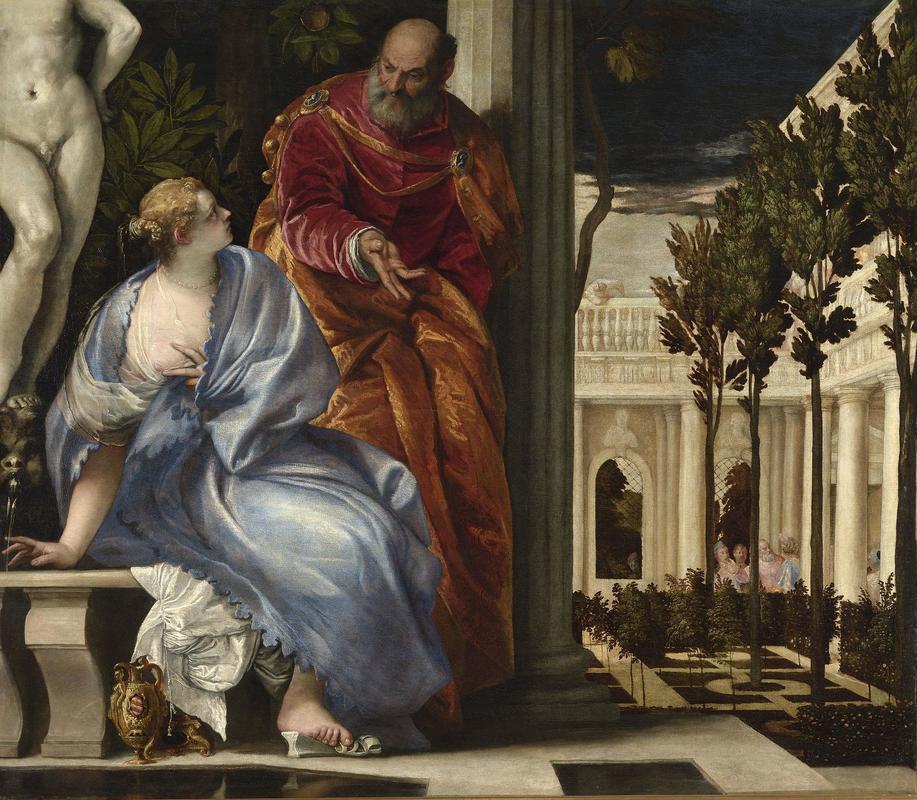More about Bathsheba Bathing

Sr. Contributor
Normally, the story of Bathsheba at her bath is used as an excuse for a lot of nudity, but Paolo Veronese gives her a bit more consideration.
The story of Bathsheba in the bible is centered around her taking a bath and then having her life ruined by a peeping tom. Said peeping tom is David, of the “and Goliath” fame, also father of King Solomon. But he’s apparently also kind of the worst. His treatment of Bathsheba shows a huge abuse of power and, while he technically gets punished, and Old Testament God was pretty harsh, his aim was a little off in this one.
So, Bathsheba was minding her own business taking a bath, and it’s worth noting it was of a specific kind. She’d just finished her monthly cycle and was having a ritual to rid herself of “uncleanliness.” It was called a mikveh and is also the same ritual bath a bride would take before getting married. The ritual symbolism is usually played upon in artistic depictions for extra sexiness points. Any sort of ritualistic cleansing is absent in Veronese’s depiction. The actual mikveh is more starkly rendered in Rembrandt’s version.
In the story, David saw Bathsheba while he was walking on the roof of a nearby palace. After spotting her, he decides to become a disgusting scumbag. He has her brought to him, and the description of the story is brief here so we don’t know what Bathsheba was told. She might have thought she was summoned by the king for news of her husband who was fighting loyally for him at war. In the original Hebrew the word used for how David's messengers “took” her closely translates to seize or take captive which gives us an idea of how little choice she had in the matter.
In Veronese’s version, it’s refreshing that there’s a lot less emphasis than usual on Bathsheba’s skin and more focus on David being a lecherous creeper. He certainly exudes an air of extreme repulsiveness, which is fitting for all his actions that follow.
But, it makes for a strange set-up in the context of the story since David didn’t directly speak to Bathsheba when she was bathing. It’s been argued by some that this painting’s subject is actually another biblical episode referencing Susanna and the elders. The problem with that is Susanna was harassed by two older gentlemen, not just one, and Veronese also already has a painting titled Susanna and the Elders.
It should also be noted that it’s been argued that the male figure isn’t David, but David’s messenger, as that would make more sense for the story. But, the richness of the man’s garments contradicts that theory. Veronese’s older brother was an embroiderer and he used his work as inspiration for his paintings. This makes it very likely he was trying to emphasize the man’s status through his clothing to make it more evident that the creepy old man is indeed King David.
As for why Veronese might have chosen this subject, there’s some speculation. Two Venetian families, the Badoer and the Soranzo, have their coat of arms depicted on the piece. The Badoer crest is on the ewer at Bathsheba’s feet and the Soranzo crest is in the shadow of the ewer, noticeably more hidden. This could indicate that the piece was commissioned for an alliance between the two families…something akin to a marriage. Seems like a subject chosen in very ill taste if it was such an occasion, but the second crest being more hidden makes it less likely this was the case.
As for how things went post-cursed bath time, David took advantage of Bathsheba after having her abducted, then sent her home. Sadly, he’s not immediately smote with a lightning bolt or anything like that. When Bathsheba tells him she’s pregnant, David doubles down on his villainy. He orders her husband moved to the front lines in battle so he gets killed, then he marries Bathsheba.
How did David finally get punished? God kills Bathsheba’s child. Which really seems like piling onto Bathsheba’s miseries more than anything kind of justice, not to mention the killing of an innocent infant. Things eventually improve for Bathsheba, though. Once David is dead, she becomes an influential queen mother to King Solomon, which is something at least.
Sources
- “Bathsheba.” Encyclopædia Britannica. Encyclopædia Britannica, inc. Accessed December 15, 2021. https://www.britannica.com/biography/Bathsheba-biblical-figure.
- Bernock, Danielle. “Who Was Bathsheba in the Bible?” Christianity.com. Christianity.com, August 19, 2019. https://www.christianity.com/wiki/people/who-was-bathsheba-in- the-bible.html.
- Crockett, Emily C. “VERONESE’S BATHING WOMEN: SUSANNA, DIANA, AND BATHSHEBA .” Veronese's Bathing Women: Susanna, Diana, and Bathsheba, 2020. https://www.academia.edu/43760997/Veroneses_Bathing_Women_Susanna_Diana… Bathsheba.
- Roberts, Helene E., ed. Encyclopedia of Comparative Iconography: Themes Depicted in Works of Art. Hoboken: Taylor and Francis, 2013.
Featured Content
Here is what Wikipedia says about Bathsheba at her Bath (Veronese)
Bathsheba at her Bath is an oil-on-canvas painting by Italian Renaissance painter Paolo Veronese, dated around 1575 and now in the Musée des Beaux-Arts de Lyon, France.
Check out the full Wikipedia article about Bathsheba at her Bath (Veronese)












